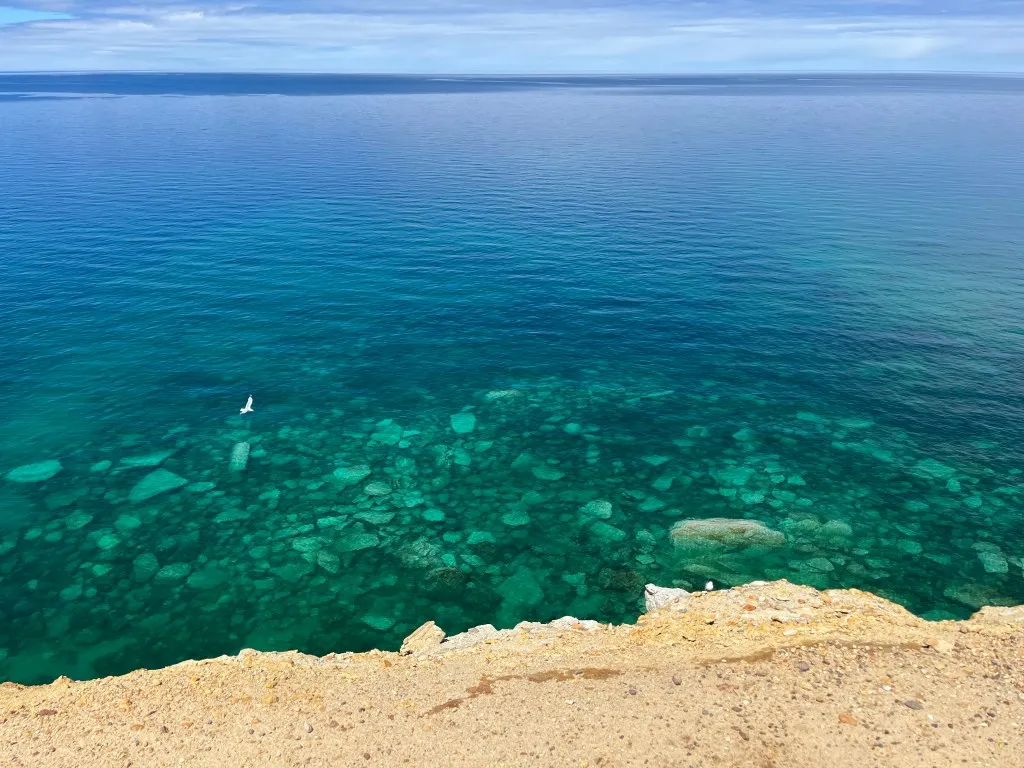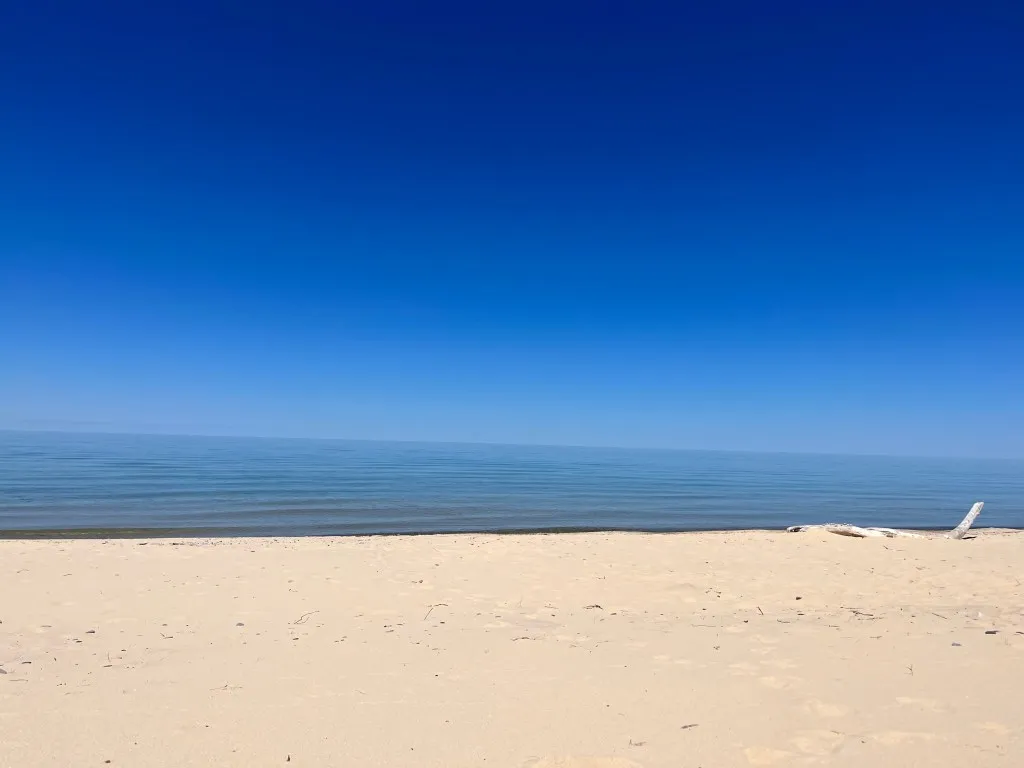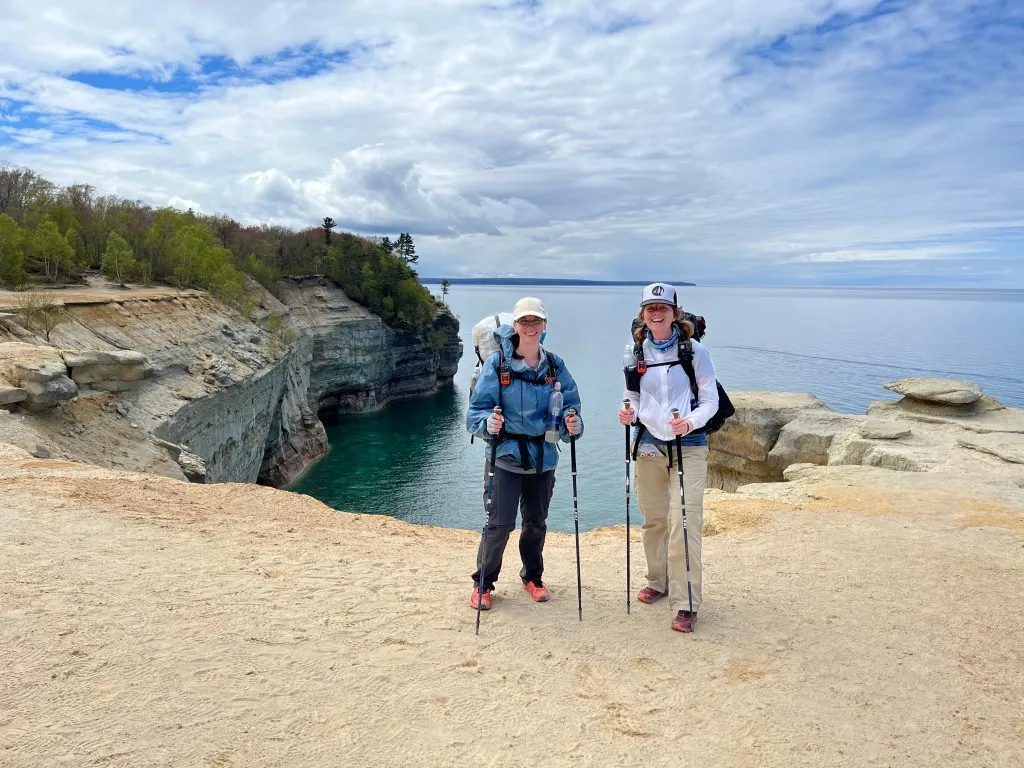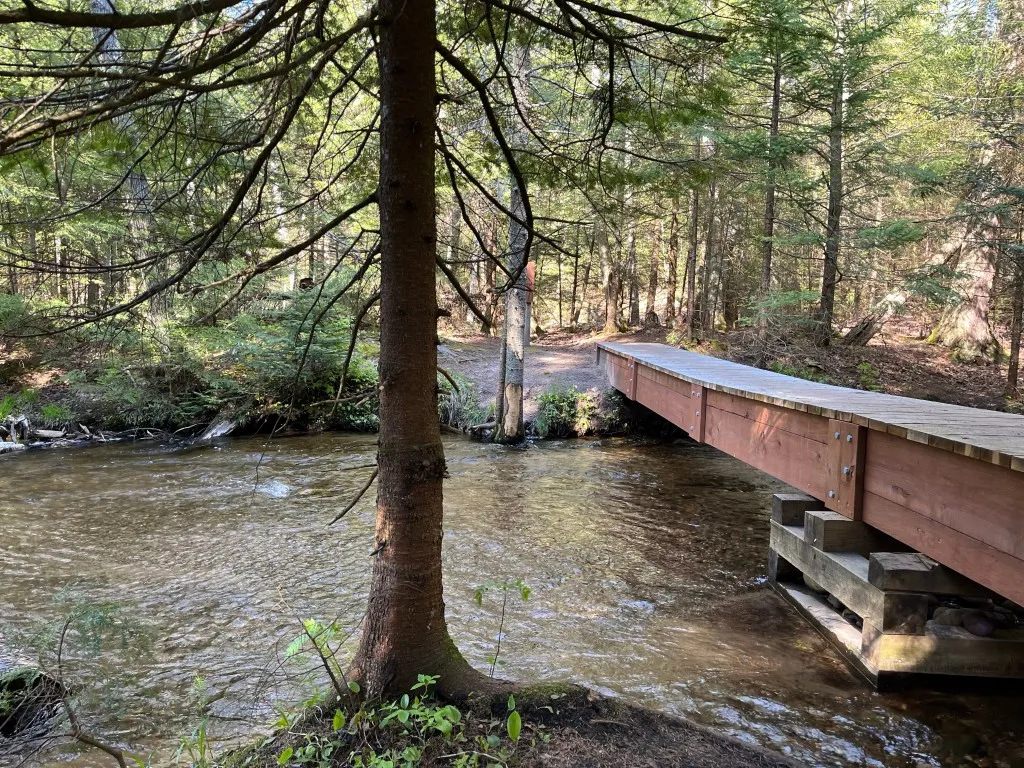The call of the wilderness is often a whisper, a subtle urge to escape the everyday and immerse oneself in nature’s grandeur. For those drawn to the rugged beauty and pristine landscapes of the Great Lakes region, backpacking Upper Peninsula Michigan offers an unforgettable adventure. Imagine towering sandstone cliffs painted with mineral streaks, vast expanses of white sandy beaches stretching along a freshwater sea, and dense forests alive with the sounds of wildlife.
Michigan’s Upper Peninsula (UP) is a gem, and Pictured Rocks National Lakeshore stands out as a premier destination for backpackers seeking stunning scenery, solitude, and a deep connection with the natural world. This journey into the heart of the UP is more than just a hike; it’s an exploration of unique geology, vibrant ecosystems, and the sheer power of Lake Superior.
Why Backpack in Michigan’s Upper Peninsula?
Michigan’s Upper Peninsula is a world away from the hustle and bustle, offering a rugged, wild experience that’s increasingly rare. Its vast forests, dramatic coastline along Lake Superior, and numerous inland lakes and rivers make it a paradise for outdoor enthusiasts. Backpacking Upper Peninsula Michigan provides access to remote areas, breathtaking vistas, and a chance to witness the raw power of nature. The air is crisp, the night skies are filled with stars, and the diverse terrain, from sandy beaches to rocky bluffs, keeps every day interesting. It’s a place where you can truly disconnect and reconnect with yourself and the natural environment.
 Colorful cliffs overlooking Lake Superior, a key feature for backpacking Upper Peninsula Michigan.
Colorful cliffs overlooking Lake Superior, a key feature for backpacking Upper Peninsula Michigan.
Among the many destinations in the UP, Pictured Rocks National Lakeshore stands out. Established in 1966 as the first National Lakeshore, it protects a stunning 42-mile stretch of Lake Superior coastline. The park is famous for its vibrant, multicolored sandstone cliffs, sea caves, arches, and dynamic sand dunes. Backpacking along the Pictured Rocks section of the North Country Trail is a quintessential backpacking Upper Peninsula Michigan experience, combining dramatic coastal views with serene forest hiking.
Planning Your Backpacking Trip to Pictured Rocks
Embarking on a backpacking trip in Pictured Rocks requires careful planning, especially as it’s a popular destination. Permits and reservations are mandatory for backcountry camping, and securing a spot, especially during peak season, can be competitive. We opted for an early season trip in late May, which meant fewer crowds but also cooler temperatures and some park amenities still closed before Memorial Day. Being prepared for variable weather is crucial; Lake Superior is known for its sudden changes, bringing cold winds, rain, or even snow, even into late spring. The official Pictured Rocks National Lakeshore website is an indispensable resource for current conditions, regulations, and reservation information.
Navigation along the main North Country Trail section is generally straightforward as the path is well-worn, but backcountry campsite locations can sometimes be tricky to find using only basic maps or GPS. Adding specific campsite GPS coordinates to your device before setting out is a wise precaution. Remember that dogs are not permitted on wilderness trails within the park, and proper food storage using provided bear boxes at campsites is required to protect wildlife and yourself.
Planning for water sources is also key; while creeks and waterfalls can be plentiful in spring, reliable water access might be limited in drier seasons, making Lake Superior your primary, though very cold, water source requiring filtration. This planning ensures a safer and more enjoyable experience while backpacking Upper Peninsula Michigan.
The North Country Trail: A Pictured Rocks Adventure
The centerpiece for backpacking Upper Peninsula Michigan within the National Lakeshore is the roughly 42-mile segment of the North Country National Scenic Trail. This trail stretches for 4,800 miles across eight states, and the Pictured Rocks portion is easily one of its most scenic stretches. The path generally follows the Lake Superior shoreline, offering continuous stunning views, though it occasionally dips inland through lush forests.
 Hiking along a sandy section of trail during a backpacking journey in Upper Peninsula Michigan.
Hiking along a sandy section of trail during a backpacking journey in Upper Peninsula Michigan.
The trail terrain varies significantly. Expect stretches of relatively flat, well-maintained forest path interspersed with challenging sections of deep, soft sand, particularly near the dunes and beaches. While the elevation gain is minimal, the sand can make hiking feel like a constant uphill slog and significantly impact your pace and energy levels. Despite the sandy challenge, the reward is the incredible diversity of landscapes encountered along the route, from the colorful Pictured Rocks cliffs to the vast, shifting Grand Sable Dunes. This variety makes the Pictured Rocks trail a compelling choice for backpacking Upper Peninsula Michigan.
Our Pictured Rocks Backpacking Journey: Day-by-Day
Our five-day trip along the Pictured Rocks trail, though a “Plan B” adventure, turned out to be one of the most beautiful and relaxing backpacking experiences. Starting from Munising Falls, the initial miles wound through a verdant forest alive with spring wildflowers. The trail, though sometimes muddy, was easy to follow, hugging the impressive coastline. Despite missing our intended Cliffs Group Campsite initially (a reminder that even well-worn trails can hide markers!), we found a spot with stunning views of Lake Superior and enjoyed a fiery sunset. The crisp night temperatures (dipping into the 30s) were a reminder to layer up, even in late spring.
 Painting the sunset over Lake Superior from a campsite while backpacking Upper Peninsula Michigan.
Painting the sunset over Lake Superior from a campsite while backpacking Upper Peninsula Michigan.
Day two brought a longer hike, primarily along beautiful sandy beaches and overlooks. This was the section where the iconic Pictured Rocks formations truly shined, with breathtaking views of Chapel Rock, Miners Island, and Grand Island. We took ample time to linger, soaking in the scenery and the sound of the waves. A highlight was an extended stop at Chapel Beach near Chapel Rock, a unique formation with a tree growing atop it, connected by a long root. Filtering and drinking the cold, clear Lake Superior water became a daily ritual. The deep sand sections were challenging but worth it for the stunning coastal access.
The pace slowed on day three with a shorter mileage goal. This allowed for more relaxation at camp and another visit from friends who were hiking the trail in the opposite direction. The landscape continued to evolve, transitioning from sheer cliffs to more accessible white sand beaches interspersed with small, smooth stones. Reaching Sevenmile Creek camp early provided ample time to explore, eventually finding a lovely beach access point after initially thinking we were confined to the creek. Enjoying the late-setting sun by the lake and sharing stories around a campfire with fellow backpackers added to the experience.
 Campers warming up by a fire near a campsite on the Pictured Rocks trail, backpacking Upper Peninsula Michigan.
Campers warming up by a fire near a campsite on the Pictured Rocks trail, backpacking Upper Peninsula Michigan.
Day four continued the pattern of moderate mileage, allowing for leisurely mornings and extended lunch breaks for painting and drying gear. This stretch featured more diverse shoreline, including areas known as the “ship graveyard” due to shallow, rocky shoals. We passed the historic Au Sable Point Lighthouse, although it was closed for the season. The varied rock types and sandy shoals made this section visually fascinating. It was on this day that the cumulative effect of hiking on sand became most apparent, with blisters making their unwelcome appearance despite good foot care practices.
The final day covered the section leading towards Grand Sable. Approximately five miles traverse the impressive Grand Sable Dunes, massive hills of sand that constantly shift. Walking near the historic log slide area offers a glimpse into the region’s past, though attempting the slide itself is cautioned against. The transition from open dunes back into a lush forest carpeted with spring ephemerals was surreal, with sand surprisingly mixed into the forest floor.
Finishing the hike at the Grand Sable Visitor Center marked the end of a journey etched into memory, leaving behind not just incredible views but also sand in every piece of gear. This trip perfectly embodies the essence of backpacking Upper Peninsula Michigan, combining natural beauty with physical challenge and rewarding solitude.
Lessons Learned on the Trail
Every backpacking trip offers takeaways, and our Pictured Rocks adventure was no exception. The slower pace we adopted significantly enhanced the experience, allowing us to truly appreciate the stunning surroundings without feeling rushed. This trail is not one to simply conquer miles on; it’s meant to be savored. The unexpected challenge of hiking on deep sand was a major lesson. While physically demanding, it also highlighted the unique coastal environment. It required extra attention to foot care; proactive measures are essential when dealing with sand that inevitably gets everywhere.
Cold Lake Superior nights, even in late spring, reinforced the importance of versatile layering and having a warm sleeping system. Despite packing warm gear, the dampness and cool temperatures made extra insulation desirable. Running out of stove fuel a night early was a minor inconvenience but a good reminder to either carry a larger fuel canister or carefully calculate usage for morning and evening hot meals/drinks, particularly on trips longer than a few days. These practical lessons, combined with the unforgettable natural beauty, are all part of the rich tapestry of backpacking Upper Peninsula Michigan.
Essential Gear and Packing Tips
Packing wisely is key for a comfortable experience when backpacking Upper Peninsula Michigan, especially given the variable weather and unique terrain like sand. Our gear list was largely similar to a previous trip, weighing around 30 lbs with food and water. Key items included layered clothing suitable for temperatures ranging from the 30s to 50s Fahrenheit, rain gear, and sturdy hiking boots (though trail runners might fare better with sand). A comfortable backpack with good hip support is essential, as even moderate weight feels heavier on sandy ground.
Utilizing provided bear boxes at campsites eliminates the need for bear canisters or hanging food bags, saving weight and hassle, though using odor-proof bags within the bear box is still recommended. A reliable water filter is non-negotiable, especially when relying on Lake Superior. Beyond the essentials, bringing items that enhance your personal experience, like a lightweight camp chair for relaxing or art supplies for capturing the scenery, can make the trip even more rewarding. For more detailed tips on foot care specifically for sandy conditions, it’s worth researching techniques beyond standard blister prevention, as sand introduces a unique challenge.
Beyond Pictured Rocks: Other Backpacking in Upper Peninsula Michigan
While Pictured Rocks National Lakeshore is a highlight, the opportunities for backpacking Upper Peninsula Michigan extend far beyond its famous cliffs. The UP is crisscrossed with numerous trails, including other segments of the North Country Trail, state forest trails, and pathways within state parks like Porcupine Mountains Wilderness State Park, known for its rugged terrain and expansive old-growth forests.
These areas offer different experiences, from challenging inland climbs to remote lake shorelines. Planning a trip to other parts of the UP can reveal diverse landscapes and less-trafficked routes, offering a variety of challenges and rewards for backpackers. Exploring different regions allows you to fully appreciate the varied beauty available when looking into backpacking lower michigan or the equally stunning northern reaches.
FAQs about Backpacking the Upper Peninsula Michigan
Is a permit required for backpacking in Pictured Rocks National Lakeshore?
Yes, permits and reservations are mandatory for all backcountry camping within Pictured Rocks National Lakeshore. Reservations are highly recommended due to popularity.
What is the best time of year for backpacking in Upper Peninsula Michigan?
Late spring (late May to early June) and fall (September to early October) often offer beautiful scenery and fewer crowds. Summer is popular but can be busy and bring more bugs (mosquitoes, black flies). Be prepared for variable weather in any season, especially near Lake Superior.
How difficult is the Pictured Rocks backpacking trail?
The Pictured Rocks trail is generally considered moderate. While elevation changes are minimal, the challenging sandy sections can significantly increase the difficulty and cause fatigue, particularly over multiple days. Daily mileage and personal fitness play a big role.
Are there reliable water sources along the Pictured Rocks trail?
Yes, Lake Superior is a constant source, but water must be filtered or treated. Numerous creeks and waterfalls cross the trail, especially in spring, but their flow can decrease later in the season. Planning for water access is important.
Do I need to worry about bears while backpacking in Upper Peninsula Michigan?
Yes, black bears are present in the Upper Peninsula. Pictured Rocks provides bear boxes at all backcountry campsites for proper food storage. It is crucial to use these facilities and follow Leave No Trace principles regarding food and waste.
Conclusion
Our backpacking trip along the Pictured Rocks National Lakeshore was a vivid reminder of the stunning natural beauty and challenging rewards that come with backpacking Upper Peninsula Michigan. From the dramatic cliffs and pristine beaches to the lessons learned about sandy trails and variable weather, the experience was deeply enriching. The UP offers a wilderness escape that feels both remote and accessible, inviting adventurers to explore its diverse landscapes. Whether you’re drawn to the famous Pictured Rocks or seek solitude on lesser-known trails, the opportunities for unforgettable backpacking experiences in this corner of Michigan are endless. Pack your bags, prepare for adventure, and discover the magic of the Upper Peninsula for yourself.
